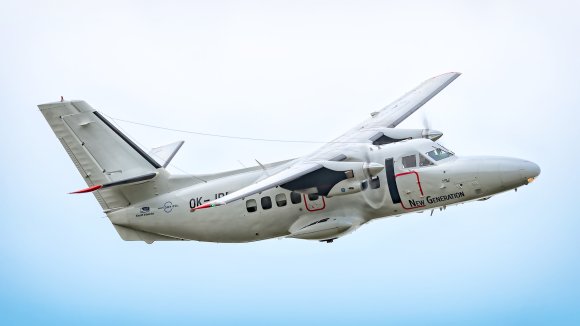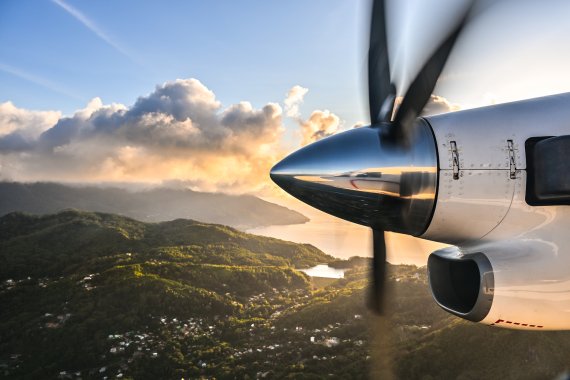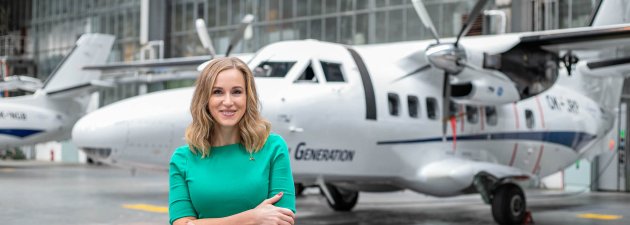“We are crazy about airplanes. Otherwise, this wouldn’t work,” Alena Medová, Chairman of the Board at Aircraft Industries, begins our conversation. It was precisely this passion for aviation and the responsibility for the tradition built by past generations that led Richard Háva, head of the Omnipol Group, to take a risk three years ago. He decided not to let the renowned Czech brand fall, and bought Aircraft Industries from its Russian owner. The Kunovice-based company had faced existential difficulties after sanctions were imposed on Russia, which was almost its only market at the time. The famous L 410 aircraft thus effectively returned home after many years. Richard Háva’s vision was not only to save this legendary turboprop aircraft, of which Omnipol had historically sold hundreds around the world, but also to return it to where it belongs – the global market.
After three years, can you say that your mission has been successful?
We have achieved a lot, and I am convinced that the results are already visible, although we still have the biggest part of the job ahead of us. We managed to bring the L 410 back onto the international aviation scene, proving that it exists, that it has its advantages and that, as a traditional Czech manufacturer, we are able to offer not only a quality product but also flexibility and reliable services – such as technical support training, pilot training and long-term servicing over decades.
Since taking over the company, we have sold nearly twenty aircraft worldwide, and this year, we aim to deliver another fourteen. We could sell even more, but we cannot manage it in terms of capacity yet, neither we nor our supply chain, which includes 600 Czech companies. To sum up, we have completed the first part of our task – massive marketing. The second part will involve investment in development and production to increase our capacity. I believe this phase will be more challenging. However, if we all approach it with the same enthusiasm and motivation as we have so far, I believe that we will be selling dozens of aircraft a year in the foreseeable future.

The legendary L 410 NG aircraft
The restart began in Jakarta
The merger of Omnipol with Aircraft is unique because it builds on a proven tradition. After all, Omnipol has sold thousands of aircraft worldwide during its ninety-year history, including the L 410. So they provided you with their contacts and know-how, and helped restart new markets, is that correct?
You are right. The merger of the Czech owner and the Kunovice production plant has proven to be very fortunate. The owner and company management are on the same page, they understand each other and share the same goal - the synergy works naturally. Together, we conducted a market analysis, benchmarked the competition, studied the product, and understood what makes it unique. Omnipol opened their business network to us, provided contacts, and brought their foreign trade experience.
We knew that we had to start by making ourselves visible again after years of absence. We needed to show that both the company and the aircraft exist and what they can do. It was essential to present it as a Czech and European aircraft. During the time when it was sold almost exclusively in Russia, many clients considered it a Russian product. We needed to change that perception, too. So, shortly after acquiring the company, we launched our global roadshow. We started in markets that are traditional for Omnipol, particularly in Central Asia, and expanded from there.
Where did the L 410 make its post-hiatus debut?
It was in 2022 at the Indo Defence Expo & Forum in Jakarta, Indonesia, which is the largest event of its kind in Southeast Asia. I remember that the presence of our aircraft there created a massive buzz and interest. It was our icebreaker. The world found out that the L 410 is still alive, that it’s a new version and that it has a new Czech owner. It also helped that one L 410 had already been flying in Indonesia at that time. It had been bought by the former Minister of Fisheries some eight years before, who loved the aircraft and has served as a great reference for us there.
We consider Southeast Asia to be one of the most promising markets.
Have you managed to sell more aircraft to Indonesia yet?
We have established many important contacts, and we currently have several business cases in progress there. However, these will require some time. In Indonesia, doing business is a really long process, and the market is complex, particularly when it comes to aircraft financing. I must admit that we have little experience in this so far and that we are learning.
At the same time, however, we are also active in the region – in the Philippines, Malaysia and Vietnam. For example, in Vietnam, Omnipol has traditionally been successful with its aircraft, recently selling several subsonic training aircraft, the L-39 Skyfox, there. At the end of last year, together with other Omnipol subsidiaries, we participated in the Vietnam Defence EXPO trade fair at Gia Lam Airport in Hanoi, where we presented our new all-metal high-wing turboprop aircraft, the L 410 NG.
Strengths of the Kunovice Legend
How do you manage to convince global markets that your aircraft is the right choice for them? After all, the competition is fierce, and you have lost many years when you were visible only in Russia.
The L 410 is unique because it is a partner in times of trouble – it won’t leave you stranded. It’s a reliable, durable and very simple aircraft concept. People call it the "flying Land Rover" because it has proven itself in very difficult terrain, can take off and land on short, unpaved runways and can transport nineteen passengers or cargo to inaccesible areas. The aircraft can withstand temperatures ranging from plus fifty to minus fifty degrees Celsius, is very easy to maintain and repair. Unlike Western aircraft, which are very sophisticated and require more complex maintenance.
Additionally, our model is multifunctional – customers can reconfigure it according to their needs. It can serve as an air ambulance, VIP transport or reconnaissance aircraft, it can monitor borders and gather information.
One thing I’d like to emphasize is that the lifecycle of our product is thirty to forty years. Today, we can manufacture aircraft that last 40,000 to 45,000 flight hours.

Guaranteed warranty
It could then be said that sustainability is in your DNA, along with one of the longest warranties.
Yes, I like to say that selling the aircraft is just the beginning of our work because then we are committed to keeping it airborne throughout its lifecycle. We must be ready to provide service support, have spare parts and be able to modernize it when it becomes obsolete.
Are you considering developing a new aircraft?
We must look ahead, as the aviation market is evolving rapidly. We know that we will need to respond to changing needs. In some regions where we currently sell the most, infrastructure will eventually develop, and the L 410 may no longer be as necessary. We are considering a pressurized aircraft that could fly at higher altitudes while still retaining some of the L 410’s key advantages, such as the ability to take off and land on short, unpaved runways.
However, that’s a vision for the future. Today, we are focusing on enhancing the current model. We want to introduce new modifications, exploring the capability to land on water for example and focusing on the ISR concept. There are many directions we could take, and our development team has a lot of ideas on how to keep us at the top of the global market for many years to come.
Alena Medová was interviewed by Jana Jenšíková
Photo credits: Aircraft Industries



